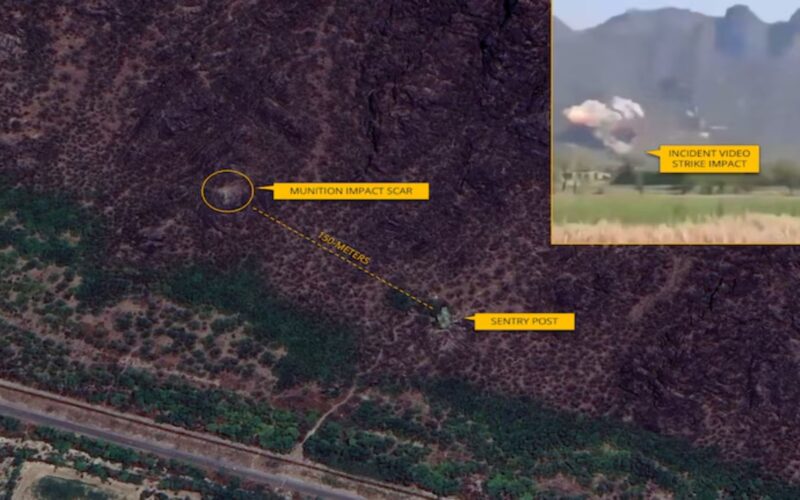New Delhi/Islamabad (National Times): New satellite imagery has surfaced, appearing to confirm a missile strike by India on Pakistan’s sensitive Kirana Hills region, home to key elements of its nuclear infrastructure. The development marks a significant turn in the narrative around Operation Sindoor, the covert Indian military campaign carried out in May 2025.
The imagery, captured by Google Earth in June 2025 and analyzed by noted geo-intelligence expert Damien Symon, reveals what appears to be a missile impact point in the Sargodha district of Pakistan’s Punjab province — specifically, in the Kirana Hills, long linked to the country’s nuclear program.
“Imagery update from Google Earth of the Sargodha region, Pakistan, captured in June 2025, shows — 1. The impact location of India’s strike on Kirana Hills in May 2025; 2. Repaired runways at Sargodha airbase post-India’s strikes in May 2025,” Symon posted on X.
The analysis points to evident repairs at Sargodha Air Base, suggesting the facility sustained damage during the strikes and was quickly restored due to its strategic significance. The base lies just 8 km northwest of Kirana Hills — a site believed to house underground nuclear storage tunnels and linked to Pakistan’s subcritical nuclear tests of the 1980s.
The new revelations challenge official claims from both sides. Following the operation, the Indian Air Force (IAF) publicly denied targeting the Kirana Hills. In a now-viral press briefing on May 12, Air Marshal A.K. Bharti, Director General of Air Operations, dismissed the notion with a wry remark:
“Thank you for telling us that Kirana Hills houses some nuclear installations. We did not know about it. We have not hit Kirana Hills. I did not brief in my briefing yesterday.”
His knowing smile, however, only added fuel to speculation.
Meanwhile, Pakistan has neither confirmed nor denied any strikes in the Kirana region. Independent analysts continue to examine the satellite evidence, while Islamabad has maintained an official silence on the issue.
Adampur Airbase Strike Claims Disproven
During the same conflict period, Pakistan claimed to have struck India’s Adampur Airbase, allegedly damaging a Su-30MKI fighter and destroying an S-400 air defense system. However, those assertions have now been widely debunked.
Satellite images from March 2025, shared again by Damien Symon, showed a MiG-29 undergoing routine engine tests at Adampur. The blackened marks near the site, cited by Pakistani media as evidence of a missile hit, were in fact consistent with standard soot from maintenance activities.
Adding to the counter-narrative, Indian Prime Minister Narendra Modi visited the Adampur base shortly after the conflict. Photos showed him standing beside an intact S-400 unit, further discrediting Islamabad’s claim.
Strategic and Political Implications
The emerging details of Operation Sindoor, especially the alleged hit on Kirana Hills, underscore the high-stakes nature of the recent India-Pakistan standoff. If verified, a strike on such a sensitive location marks one of the boldest military actions in the region’s recent history — with deep ramifications for South Asian nuclear stability.
While official channels remain tight-lipped, the growing body of open-source satellite intelligence is shaping public understanding and strategic discourse.
A formal response from Islamabad — if and when it comes — could redefine the trajectory of bilateral relations, already strained after the May hostilities. As experts continue to verify and analyze satellite data, questions linger over the full scale and intent of Operation Sindoor — and what it signals about the future of regional security architecture.

